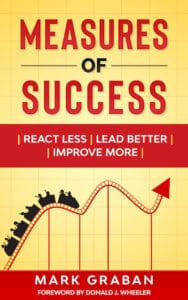 I'm still working on my book Measures of Success, as I've mentioned here a few times. I've gotten some positive feedback and some constructive criticism from early readers that will make this a better book. I just posted an update yesterday, by the way.
I'm still working on my book Measures of Success, as I've mentioned here a few times. I've gotten some positive feedback and some constructive criticism from early readers that will make this a better book. I just posted an update yesterday, by the way.
(EDIT – the book is done)
The partial “in-progress” book is available through LeanPub.com. Or, when it's done, it will also be is available through the Amazon Kindle bookstore and I will also produce a paperback version.
My goal is to have the book done by the Lean Healthcare Transformation Summit in mid-June (hope to see you there at the Summit and/or my workshop on these topics).
I also did a webinar that was hosted by my friend Mike Stoecklein and his organization, the Institute for Enterprise Excellence (IEX).
About the webinar:
“Mark is writing a book which presents a practical, simple method (“Process Behavior Charts”) that separates “signal” from “noise” in our metrics (a.k.a. “performance measures”), so we can learn when and how to evaluate and respond to our metrics appropriately over time. By using this method and overreacting less often (or reacting in different ways), we can stop wasting time, and start improving more. This will also reduce frustration in the workplace and boost performance through higher morale and increased engagement.”
Here is the recording:
I hope you enjoy the webinar and find it to be helpful.
I'm glad I got a laugh out of Mike for saying that KPI doesn't mean “Kajillion Performance Indicators.”
Remember: KPI stands for Key Performance Indicators, not Kajillion Performance Indicators.
— Mark Graban (@MarkGraban) June 22, 2018
Please scroll down (or click) to post a comment. Connect with me on LinkedIn.
Let’s build a culture of continuous improvement and psychological safety—together. If you're a leader aiming for lasting change (not just more projects), I help organizations:
- Engage people at all levels in sustainable improvement
- Shift from fear of mistakes to learning from them
- Apply Lean thinking in practical, people-centered ways
Interested in coaching or a keynote talk? Let’s talk.
Join me for a Lean Healthcare Accelerator Trip to Japan! Learn More










Hi Mark,
I’d be curious on how you approach three points in your book:
– When are data not appropriate for a process behaviour chart? (Or, which data are not appropriate for the chart?)
– How to work with highly aggregated measures? (I guess you have a lot of these in healthcare?)
– How to successful disaggregate data to make the data more informative and actionable?
I had to look at some yearly data on a chart yesterday – highly aggregated and no signals in the data. We disaggregated the data and then lots of signals…
Thanks, Scott.
The “X and MR” chart that the process behavior chart methodology is built on is called “the Swiss Army knife of control charts.” It doesn’t require normally distributed data, for example.
One challenge is with data where the average is very small, like the average number of patient falls in a unit per day. If your data is basically 0 or 1, then any “1” might look like a special cause. One alternative is to plot the “days between falls,” a metric that resets each time a patient falls.
As for highly aggregated measures, I do make a point in the book that daily metrics (when you have them) are better than weekly metrics, which are better than monthly, and monthly’s better than annual.
The rule of thumb is that you need 20 historical data points to create the Natural Process Limits, so annual cycles are very slow for this.
I think doing more frequent metrics is the way to go and the process behavior chart methodology teaches us how to not overreact more frequently to every up or down in the chart.
Does that help?
Thanks Mark.
I like your direction.
My point was more if your book will directly address such points. It would be a shame to see someone try out a technique as useful as the process behavior chart and not make a progress because the situation doesn’t fit the approach.
Increasing frequency of data collection is one element. It can for sure help and it can increase the potential sensitivity of the chart (to detect change) but the frequency has to make sense. The choice of frequency requires user judgement so how to help the user make a successful judgement? (In manufacturing one can see online data put on an XmR chart at high frequency and the limits are way too narrow to be useful. In such a case the chart is a combination of useless and misleading. The user that has used the technique badly then thinks the technique doesn’t work…)
Another example: Could it be that hospitals chart admissions but have for example systematically more admissions on a certain day than others? Here if the frequency became daily (before say it was weekly) you’d have to be careful charting days of the week in sequence.
Thanks, Scott.
Hi Scott –
The easiest thing to address here is that if it’s a high-frequency chart, like a daily chart, then the day-to-day variation will be higher than the variation of a week-to-week chart. So, the limits on a daily chart will be wider than a weekly chart. The limits wouldn’t be “too narrow to be useful.”
This article talks about deseasonalizing data:
https://demingalliance.org/resources/articles/process-behaviour-charts-an-introduction
It’s important that we are charting “rational subgroups” and there are times we need to be mindful of that seasonality.
Mark
Comments are closed.